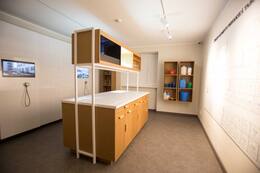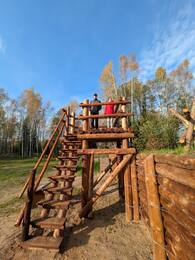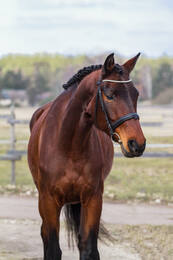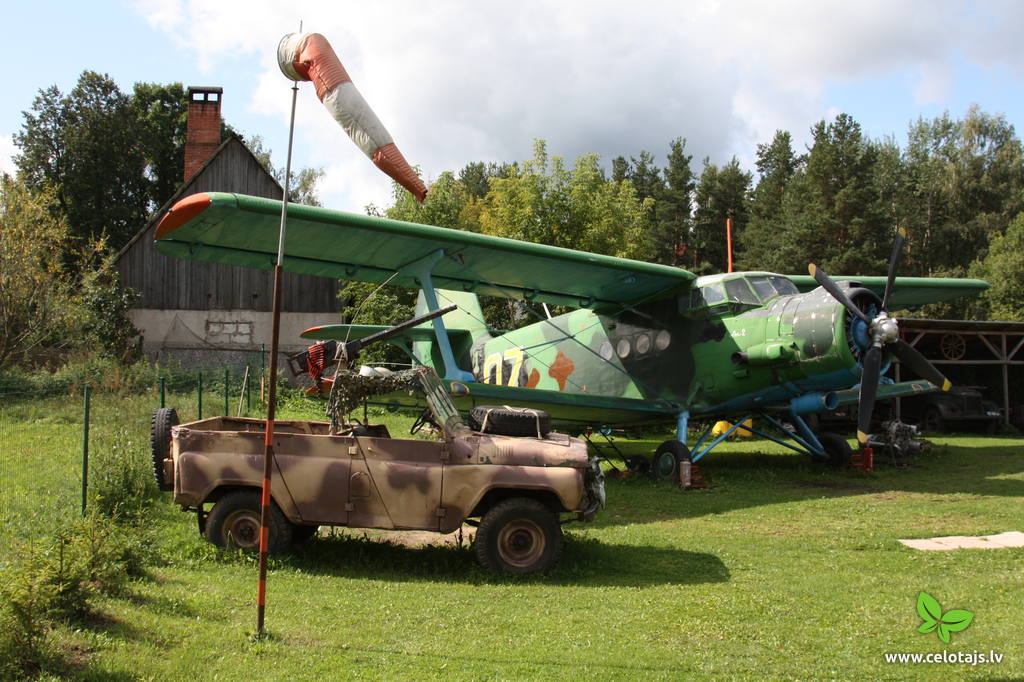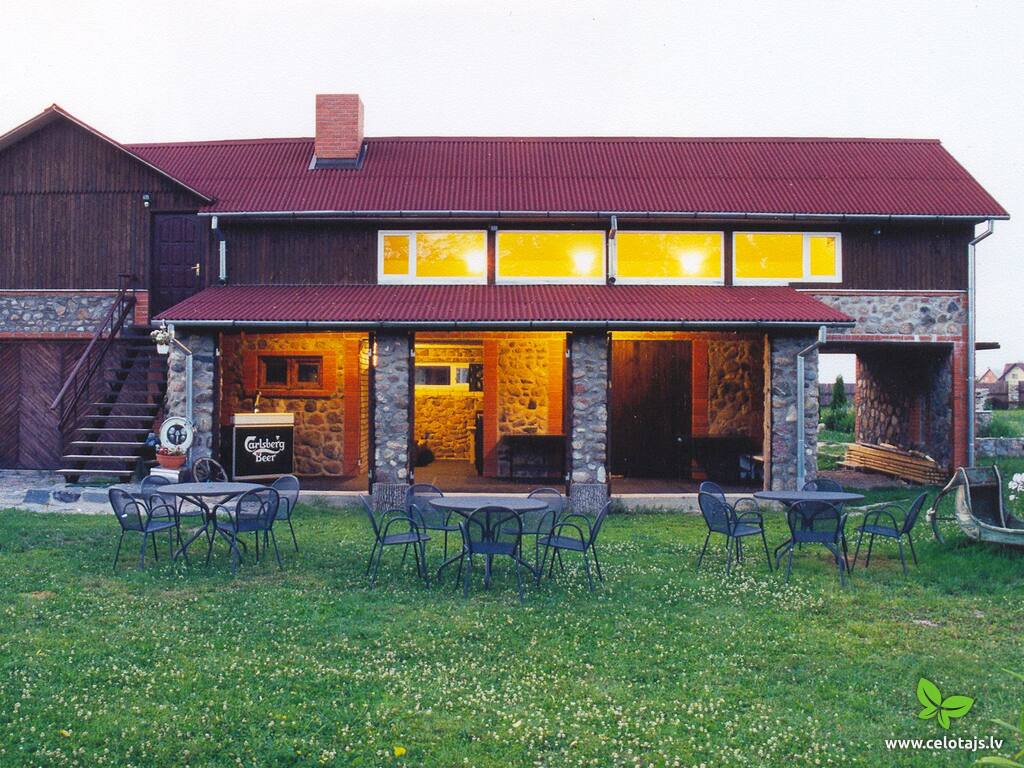Evidence of the World War I and Christmas Battles in Rīga region
Day 1.
180 km
Rīga – Ciemupe – Ogre – Tīnūži – Ikšķile – Olaine – Ložmetējkalns – Tīreļpurvs
Practical info
- Driving distance: 180 km
- Due to distances and time, 4 of the listed sights can be visited on this day
- Museum in “Tīnūži Manor” is open only on working days
- Visiting the “Tīreļi Distillery” by advance booking
- Opening hours of the Olaine History and Art Museum Museum and the dugout reconstruction should be checked in advance. The World War I Historical Exploration Route is open 24/7
- The indoor exposition of the Christmas Battles museum is open from Wednesday till Sunday. Outdoor exhibitions are open 24/7
Sights
Cafe “Dakota” and exposition of military vehicles and equipment
Cafe Dakota is located in Ogre municipality, Ciemupe, on the A6 highway. The exhibit on military heritage allows its owner to combine his hobby and interest in military history with his business of running a cafe. Here you can enjoy a meal and see military equipment, weapons, soldier equipment and aircraft from the end of the 20th century. The exhibit is available to cafe visitors during working hours. Tours are available only in Russian and prior registration is required.
Cultural Heritage Centre "Tīnūži Manor"
The Cultural Heritage Centre ‘Tīnūži Manor’ is located in Ogre municipality, Tīnūži village, 7 km from the cities of Ogre and Ikšķile. The first written evidence about the manor dates back to the 16th century. Until the mid-18th century it was considered an economic production unit with small and insignificant buildings. But over time it grew into a large farm. During World War I, battles between the Russian and German armies took place here, and the Latvian Riflemen were also involved. During the War of Independence Tīnūži manor was used as the headquarters and armoured car park of the 1st Valmiera Infantry Regiment of the Latvian Army. In 1932, the manor was given to the Union of the Latvian War Invalids, which provided accommodation and care for war veterans. During World War II (in 1943) the German Army unit FAT 212 was transferred from Estonia to Tīnūži manor. It was a saboteur unit that prepared soldiers to fight the Red Army. Latvian soldiers were also trained in the arts of intelligence gathering, guerrilla warfare tactics and sabotage. The lord house of Tīnūži manor was destroyed when the Red Army was moving towards Riga. Nowadays it is a place with a beautiful landscape and historical buildings on the banks of the Little Jugla River. Exhibits dedicated to historical events, including the ones concerning the Latvian Riflemen, can be seen at the Cultural Heritage Centre ‘Tīnūži manor’.
Olaine History and Art Museum
The exhibit in the Olaine History and Art Museum is about the period of Soviet occupation in Olaine. A World War I exploration route with restored elements of the fortifications has been created in the territory of the museum. On the site, where the World War I Russian Army defence line once was, a Russian soldier-type dugout has been built and a fragment of a shooting tower can be viewed by visitors. A World War I reinforced concrete fortification can be seen in Jaunolaine, at the intersection to Plakanciems. During World War I, active battles were fought between the Russian and German armies in this area. Latvian Riflemen units were involved in intelligence and various other operations. Marshy lands made it difficult to defend, but this was a very important area in Latvian military history. Olaine was formed due to the convenient location between Jelgava and Riga, where Jaunolaine is currently located. The Olaine manor was nearby. The modern day Olaine was built during the Soviet occupation, when industrial companies began their operations there.
Christmas Battle Museum
The museum is located in “Mangali” house, Valgunde Rural Territory, Jelgava Municipality, and it is a branch of the Latvian War Museum. It was unveiled in 2005 at the site of the Christmas Battles that occurred during World War I. Unique World War I fortifications still remain at the battle sites. The open-air exhibition of the Christmas Battle Museum reconstructs a section of the fortification system – the trench shelter and part of the first line of German defence – the “German rampart”, which is the only object of this kind in the Baltic states.
The Christmas Battles are one of the best known and most dramatic events of World War I in Latvia. They are an event of special importance in Latvian military and cultural history. Intense fighting took place for six days, leading to heavy casualties. The battles are mainly associated with the attack of Latvian Riflemen against the German Army units, which took place in particularly severe and unfavourable winter conditions. This is an unprecedented case of a major combat operation launched without artillery support.
Today, the museum artefacts found at the sites of the battle are on display. The indoor exhibition is open at certain times, while the exhibition of outdoor fortifications is open every day. Tourist routes and nature trails have been created in the surrounding area.
Tīreļi Distillery, horse riding with type of horses used in World War I
Tīreļi Distillery is a small, private farm and strong alcoholic drink brewery near the Christmas Battle Museum and Tīreļi swamp at the Kalnciems bridge over Lielupe. It also offers horseback rides to places significant to World War I. Horseback rides take place on the route Jaunmārupe-Tīreļi and Tīreļi-Jaunbērze. During this ride you'll get the chance to see the surroundings, memorial sites, trenches, Ložmetējkalns and other historical places. Horses are of the same breed that was used during World War I. You can also take a tour of the brewery and see the farm animals. Places for rest, picnics and camping are also available.
Places to eat
Cafe “Dakota” in Ciemupe village
Pub “Aitiņlauvas”, the 22nd km on A9 road
The saloon is on the edge of the Rīga-Liepāja highway (A9) at the 22 km road marker. Most of the dishes are based on ingredients from the forest. The interior design is based on hunting, and there is a paddock of wild deer alongside the restaurant.
Latvian cuisine: Roast buck, roast wild boar, venison steak, roast lamb, stuffed river trout.
Bread bakery and cafe “Lāči”, the 13th km on A9 road
Lāči brand bread is popular in Latvia and abroad, because the bakery uses ancient mastery and skills. Baking traditions are supervised by 2 master bakers and 4 journeymen. You can take a tour of the bakery, knead and bake your own little loaf of bread, have lunch at a cosy saloon and purchase the bakery’s products. Lāči uses its own ingredients for its dishes, combining them with seasonal products from local farms. The bakery shop offers a wide range of products from bread to confectionery.
Latvian cuisine: Cream of mushroom soup, various hot potted dishes, bread soup, baker’s dessert.
Pub “Eglieni”, the 39th km on A9 road
The saloon is on the edge of the Rīga-Liepāja highway (A9) at the Eglieni leisure complex, which merges the Latvian environment with the modern environment. Herbs come from the complex’s own garden.
Latvian cuisine: Cold beet soup, herring with cottage cheese and soured cream, grit sausage with cottage cheese balls, stacked rye bread, cottage cheese dessert with compote, country teas, kvass.
Special foods: Mushroom soup and filet of chicken stuffed with mushrooms.
Places to stay
Guesthouse “Pilsētnieki” in Slampe village
Guest-house for vacationers and celebrants. 7 well equipped bedrooms, room for seminars, tent and trailer sites. Fishing and swimming in the pond. Sauna.
Šlokenbeka manor near Tukums
The estate in Milzkalne that is along the banks of the Slocene River dates back to the 15th century, when it was built as a closed complex for the Livonian Order. It is the only fortified estate of its type to have survived to the present day, and it was once used as a hiding place for aristocrats during an attack. The gate towers with their ornate weather vanes were built in the late 17th century, and the ancillary buildings date back to the 18th and 19th century. A brick wall with firing apertures survives. The Latvian Road Museum is in one of the wings of the complex, while the former mansion offers accommodations, tours and tastings of local goodies.






